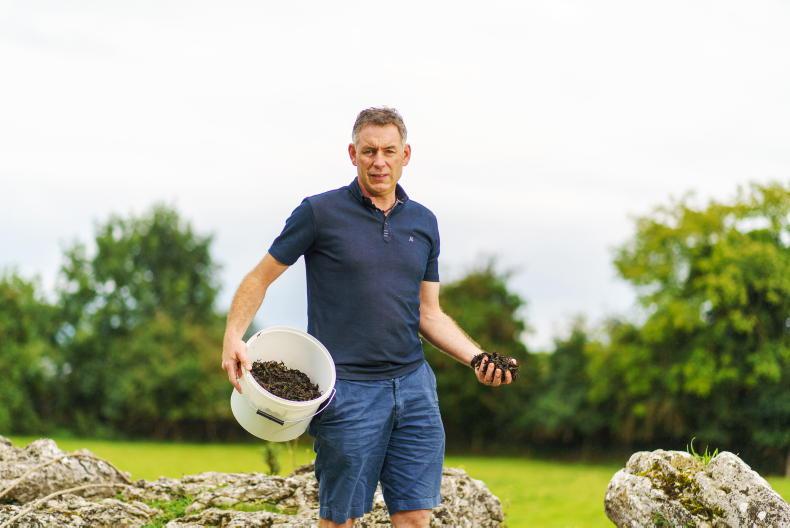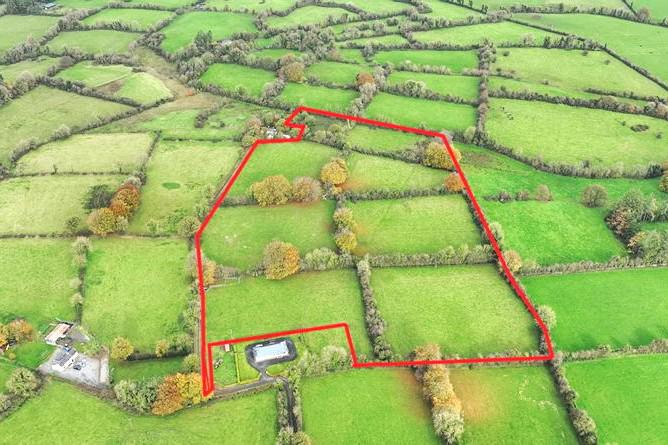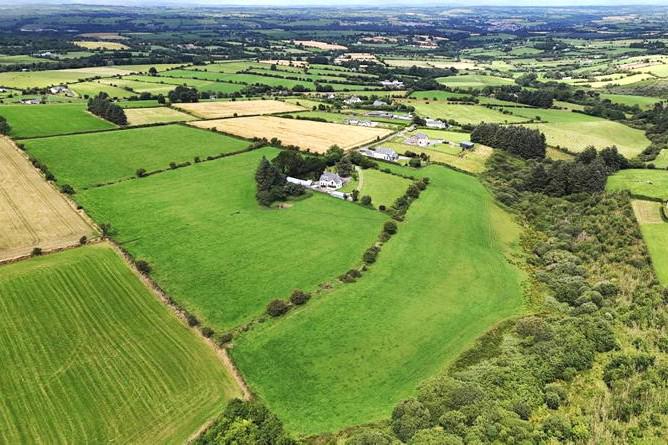In last week’s Sea of Potential article, we looked at some of the ongoing research concerning seaweed harvesting in Ireland – these studies are, among other things, looking at the impact increased harvesting could have on our ocean environments.
This week, we’re looking at the ways seaweed can help Irish farmers reach on-farm environmental sustainability goals.
For centuries, seaweed has been used as a form of animal feed and fertiliser on Irish farms, and today we have the scientific research to help justify this long-standing tradition.

Ollie Greene of Betterplants.ie \ Barry Cronin
Seaweed has numerous qualities which make it ideal to not only support the growth of gardens and crops, but to condition the soil, as well. It usually contains a mixture of nitrogen, potassium, magnesium, phosphate and potash, among many other nutrients and minerals.
Commercial seaweed fertilisers
Ollie Greene operates Betterplants.ie, which offers a line of natural Irish seaweed fertilisers and animal supplements for commercial and domestic growers, farmers and pet owners. He started out making liquid seaweed fertiliser for his own use. Though he is based inland (in Mullingar, Co Westmeath), he loves to surf and would often collect seaweed to take home with him while on a surfing trip.
“At the time, I was growing my own vegetables,” he says. “We also had some animals. I was always looking for something natural to use in the garden. When I was surfing, I would bring barrels and fill them up with seaweed [to bring home]. Using seaweed fertiliser I could see the benefits straight away; in the vegetables and even in the animals.”
Export
Once Ollie established his business, he partnered with a seaweed harvesting company in Co Donegal. The seaweed is processed in Donegal before being packed and shipped out from Ollie’s base in Mullingar. His agri-focused product line includes both liquid and pellet fertiliser, horse and chicken seaweed supplements, livestock supplements (including seaweed “licks”) and extra-strength slurry inoculant.
In recent months, Ollie started shipping products (particularly their pet seaweed supplements) to areas as far off as Dubai and South Korea.
“We do business in the UK and more recently we ended up in Dubai,” he says. “They loved our product [there] and we now have a nice customer base. In Korea they love their pets and have taken a shining to our pet supplement.”
A bright future in seaweed
Ollie says despite the pandemic and Brexit, business is doing well and it’s actually his farming clients – both organic and conventional – who are championing his seaweed products. He says his Sea Supplement, which is generally given in 100g doses per day (costing roughly €0.15/head/day) is a cost-effective way to provide vital minerals to livestock.
Conventional farmers will often add the Betterplants seaweed spray to their weed killers as it enables better absorption into docks and other weeds. He also says the spray is useful at this time of year to help carry grass through the winter months.
Backed by science
Feeding livestock seaweed supplements might sound a bit new-age, but there is actually very promising research behind the practise.
The Bantry Marine Research Station takes seaweed very seriously. They operate their own licensed seaweed farm and are, piece by piece, unlocking the many areas of potential for Irish seaweed.
Currently, they are investigating a specific type of seaweed which is showing clear signs of being able to reduce methane in livestock. Dr Julie Maguire is their research director, and she feels this research is showing extreme promise.
“This all came about four years ago,” she says. “We saw a study from Australia [where scientists] found this tropical species of seaweed which would reduce methane in cattle. We kind of thought, ‘OK – we have 600 different species of seaweed in Ireland – so maybe we have one which does the same thing.’”
Finding ‘the one’
Julie and her team secured funding from Bord Iascaigh Mhara (BIM) for a year-long study to screen potential seaweed species. She says they were able to narrow it down to the ones most similar to the Australian plant, which gave them a variety of around 15 different Irish species.
“There was one [species] which stood head and shoulders above the rest, and it’s from the same family as the Australian species,” Julie explains. “It’s called asparagopsis armata. Bromoform is the active ingredient [in seaweed] which has shown to reduce methane emissions.”
Julie says this seaweed species was farmed in Ireland during the 1990s for cosmetic products, but had since been discontinued. She and her team are attempting to cultivate the seaweed to encourage growth in greater numbers.
Making spores
“You don’t want to deplete the stocks; there isn’t a lot of it there,” she says. “The best way to make a lot of it is to culture it, so BIM gave us extra funding to experiment with culturing it (which has been quite complex).
“At the moment, our big goal is to make spores,” she continues. “Once you get spores you can produce millions of plants.”

Because this type of seaweed is relatively small, it can be cleverly grown to maximise space. Also, because it is a summer plant, there is potential for seaweed farmers to grow it when they aren’t growing other types of seaweeds.
“This asparagopsis is a summer plant,” Julie says. “If seaweed farms around the country are empty during the summer, there are sites which could be used. In Ireland we have about 230 hectares licensed for seaweed, but there are also new licenses being applied for all the time. Unlike kelp, it will grow and then you can cut it like grass and it will grow back – so you could maybe get a few harvests out of it over the summer.”
Capturing bromoform
Once grown and harvested, Julie says they have mainly been drying the plant to preserve the bromoform. Then, it can be added in <1% doses to livestock feed.
If successful, Ireland could become European leaders in bromoform production; exporting it to other land-locked countries and even Scandanavia, where waters are too cool to grow this species.
“It doesn’t grow everywhere in Europe; it’s a summer plant [and likes warmer waters],” Julie says. “There’s a lot of cattle in inland European countries; they would have to import this. This could be a real growth area for us: we’re well placed as an island and we have the marine resources.
“I like the idea of seaweed farming,” she adds. “It’s another type of farming – it’s kind of like farmers helping farmers. They’ve been [farming seaweed] in Asia for thousands of years, but we only use around 13 of these 600 Irish species. It would be interesting to know what’s in the rest of them.”
betterplants.ie
bmrs.ie
Read more
Travel: Sea of Potential – making use of what you have
Sea of Potential: seaweed brings possibilities but needs more research
In last week’s Sea of Potential article, we looked at some of the ongoing research concerning seaweed harvesting in Ireland – these studies are, among other things, looking at the impact increased harvesting could have on our ocean environments.
This week, we’re looking at the ways seaweed can help Irish farmers reach on-farm environmental sustainability goals.
For centuries, seaweed has been used as a form of animal feed and fertiliser on Irish farms, and today we have the scientific research to help justify this long-standing tradition.

Ollie Greene of Betterplants.ie \ Barry Cronin
Seaweed has numerous qualities which make it ideal to not only support the growth of gardens and crops, but to condition the soil, as well. It usually contains a mixture of nitrogen, potassium, magnesium, phosphate and potash, among many other nutrients and minerals.
Commercial seaweed fertilisers
Ollie Greene operates Betterplants.ie, which offers a line of natural Irish seaweed fertilisers and animal supplements for commercial and domestic growers, farmers and pet owners. He started out making liquid seaweed fertiliser for his own use. Though he is based inland (in Mullingar, Co Westmeath), he loves to surf and would often collect seaweed to take home with him while on a surfing trip.
“At the time, I was growing my own vegetables,” he says. “We also had some animals. I was always looking for something natural to use in the garden. When I was surfing, I would bring barrels and fill them up with seaweed [to bring home]. Using seaweed fertiliser I could see the benefits straight away; in the vegetables and even in the animals.”
Export
Once Ollie established his business, he partnered with a seaweed harvesting company in Co Donegal. The seaweed is processed in Donegal before being packed and shipped out from Ollie’s base in Mullingar. His agri-focused product line includes both liquid and pellet fertiliser, horse and chicken seaweed supplements, livestock supplements (including seaweed “licks”) and extra-strength slurry inoculant.
In recent months, Ollie started shipping products (particularly their pet seaweed supplements) to areas as far off as Dubai and South Korea.
“We do business in the UK and more recently we ended up in Dubai,” he says. “They loved our product [there] and we now have a nice customer base. In Korea they love their pets and have taken a shining to our pet supplement.”
A bright future in seaweed
Ollie says despite the pandemic and Brexit, business is doing well and it’s actually his farming clients – both organic and conventional – who are championing his seaweed products. He says his Sea Supplement, which is generally given in 100g doses per day (costing roughly €0.15/head/day) is a cost-effective way to provide vital minerals to livestock.
Conventional farmers will often add the Betterplants seaweed spray to their weed killers as it enables better absorption into docks and other weeds. He also says the spray is useful at this time of year to help carry grass through the winter months.
Backed by science
Feeding livestock seaweed supplements might sound a bit new-age, but there is actually very promising research behind the practise.
The Bantry Marine Research Station takes seaweed very seriously. They operate their own licensed seaweed farm and are, piece by piece, unlocking the many areas of potential for Irish seaweed.
Currently, they are investigating a specific type of seaweed which is showing clear signs of being able to reduce methane in livestock. Dr Julie Maguire is their research director, and she feels this research is showing extreme promise.
“This all came about four years ago,” she says. “We saw a study from Australia [where scientists] found this tropical species of seaweed which would reduce methane in cattle. We kind of thought, ‘OK – we have 600 different species of seaweed in Ireland – so maybe we have one which does the same thing.’”
Finding ‘the one’
Julie and her team secured funding from Bord Iascaigh Mhara (BIM) for a year-long study to screen potential seaweed species. She says they were able to narrow it down to the ones most similar to the Australian plant, which gave them a variety of around 15 different Irish species.
“There was one [species] which stood head and shoulders above the rest, and it’s from the same family as the Australian species,” Julie explains. “It’s called asparagopsis armata. Bromoform is the active ingredient [in seaweed] which has shown to reduce methane emissions.”
Julie says this seaweed species was farmed in Ireland during the 1990s for cosmetic products, but had since been discontinued. She and her team are attempting to cultivate the seaweed to encourage growth in greater numbers.
Making spores
“You don’t want to deplete the stocks; there isn’t a lot of it there,” she says. “The best way to make a lot of it is to culture it, so BIM gave us extra funding to experiment with culturing it (which has been quite complex).
“At the moment, our big goal is to make spores,” she continues. “Once you get spores you can produce millions of plants.”

Because this type of seaweed is relatively small, it can be cleverly grown to maximise space. Also, because it is a summer plant, there is potential for seaweed farmers to grow it when they aren’t growing other types of seaweeds.
“This asparagopsis is a summer plant,” Julie says. “If seaweed farms around the country are empty during the summer, there are sites which could be used. In Ireland we have about 230 hectares licensed for seaweed, but there are also new licenses being applied for all the time. Unlike kelp, it will grow and then you can cut it like grass and it will grow back – so you could maybe get a few harvests out of it over the summer.”
Capturing bromoform
Once grown and harvested, Julie says they have mainly been drying the plant to preserve the bromoform. Then, it can be added in <1% doses to livestock feed.
If successful, Ireland could become European leaders in bromoform production; exporting it to other land-locked countries and even Scandanavia, where waters are too cool to grow this species.
“It doesn’t grow everywhere in Europe; it’s a summer plant [and likes warmer waters],” Julie says. “There’s a lot of cattle in inland European countries; they would have to import this. This could be a real growth area for us: we’re well placed as an island and we have the marine resources.
“I like the idea of seaweed farming,” she adds. “It’s another type of farming – it’s kind of like farmers helping farmers. They’ve been [farming seaweed] in Asia for thousands of years, but we only use around 13 of these 600 Irish species. It would be interesting to know what’s in the rest of them.”
betterplants.ie
bmrs.ie
Read more
Travel: Sea of Potential – making use of what you have
Sea of Potential: seaweed brings possibilities but needs more research












SHARING OPTIONS